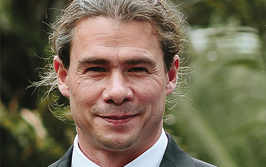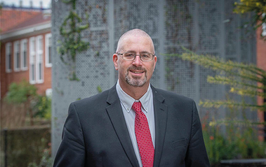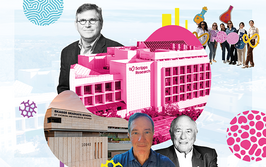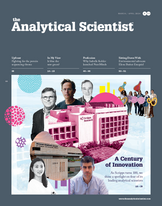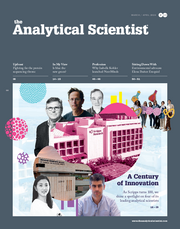Gadgeteer at Heart
Sitting Down With... Milton Lee, H. Tracy Hall Professor of Chemistry, Department of Chemistry and Biochemistry, Brigham Young University, Provo, Utah, USA.
Milton Lee | | Interview
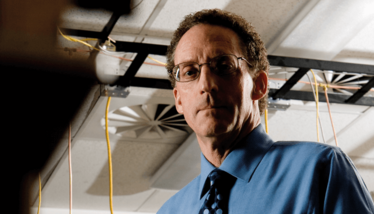
What drew you to the scientific field?
I’ve always had a desire to do practical things; at graduate school in Indiana, my interest was in environmental analysis – specifically, polycyclic aromatic hydrocarbons in air pollution, and from tobacco and marijuana smoke. I also like to build things – I’m kind of a ‘gadgeteer’. I like to see things mechanically, see electronics put together and become useful. One of the first things I did as a graduate student in Milos Novotny’s laboratory was design and build a capillary column injector for the gas chromatographs we were using. I have a tendency to get bored with repetition, and enjoy having more variety – going into the field and lab, writing papers, giving talks. I’ve always insisted on having my office right next to the laboratory so I have easy access to what my team is doing.
Collaboration seems very important to you...
Early in my career, an established chromatographer advised me that if I wanted to be successful, I shouldn’t look for collaborations with other established people, but come up with my own ideas and develop my own group. I thought that was the wrong way to approach it. Maybe that is the way to become famous, but I much prefer working with other people. I’m not interested in being my own little island! Collaboration brings expertise from a wide variety of disciplines and viewpoints – expertise that I don’t have. I’ve worked with mechanical engineers, electrical engineers, chemical engineers, microbiologists, physicists and statisticians. It also brings inspiration and fun – some of these people have become my best friends over the years. I think a lot of my success – and enjoyment – has been due to my associations with other scientists and colleagues, both in the academic and industrial worlds.
What’s the secret to successful collaboration?
The key factor is being able to get along with people and work with them effectively – and not being concerned about getting all of the credit for discoveries. Collaborations usually start with a need; first, I’ll ask around, see who has the expertise I’m looking for. In most cases, people are excited to get involved in something a little different. People who are in engineering or biology approach problems from different angles than analytical scientists. That’s how you get creativity – by building up ideas together. I encourage my students to think the same way.
How important is it to have contact with industry?
It’s deeply important. I’ve had good interactions with all the analytical companies who have produced chromatographic and mass spectrometry instrumentation. Back in the early days, I worked with Hewlett Packard; and more recently I have had great collaborations with companies like Restek, Supelco, PerkinElmer and Valco. Academicians have a lot of freedom to present at meetings and publish papers, but I feel there are industry researchers who are just as creative, but who aren’t able to publicize their work. It bothers me that they don’t receive the recognition they deserve. When you judge a person’s contribution on the number of publications, you’re immediately excluding great people in industry who don’t have that opportunity.
What has been your most rewarding collaboration?
There are many, but here is one example. When I worked in supercritical fluid chromatography, I was interested in interfacing to mass spectrometry, and one of the other professors had a postdoc working in supersonic jet spectroscopy. We got talking about what a supersonic jet ion beam would do in mass spectrometry, and came up with the idea of doing supersonic expansion of ions and orthogonally pulsing them to get maximum sensitivity. We published the first paper on orthogonal extraction-mass spectrometry where the ions were created at atmospheric pressure – an exciting instrumental project that was very rewarding to me personally.
You’re based at a church-sponsored university. How does your religion influence your work?
In the Mormon religion, family and religion go hand in hand, and being a Christian has affected my profession a lot. Some people believe that science and religion don’t go together but I look at it this way: in both science and religion, you’re seeking the truth. My scientific knowledge has never interfered with my religious beliefs. Among many things, religion teaches principles of honesty, integrity and ethics – and it’s important for me to make sure that what we’re doing in the laboratory is right, and that we’re reporting things as accurately as possible. It’s worth noting that most of my students are not Mormons; they come from all around the world and become immersed in the scientific culture of the university.
How would you define scientific success?
I think of success broadly. It can be discovering some fundamentally new phenomenon, but it can also be developing new techniques or tools, or even improving analytical practice and enhancing chemical analysis itself. I think the ultimate success, though, comes from what you do for others and what you leave behind. In my religion, there’s a saying: “No success can compensate for failure in the home”. My family is my most important ‘work’ and where I gain the greatest satisfaction. Having said that, my profession, my research and my discoveries have been enriching, exciting and challenging. A good job is one you enjoy, one that allows you to live well – and one that allows you to have a few adventures...
H. Tracy Hall Professor of Chemistry, Department of Chemistry and Biochemistry, Brigham Young University, Provo, Utah, USA.
